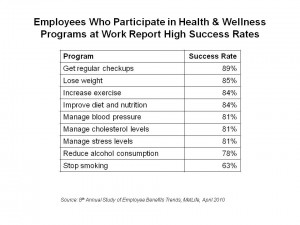 When it comes to health plans sponsored by U.S. employers, there are two realities facing benefits managers: on one side of the coin, most U.S. employers held the line on employee benefits in the recession. The other reality: controlling costs is the most important objective for employee benefits, according to most U.S. employers polled in MetLife’s 8th Annual Study of Employee Benefits Trends.
When it comes to health plans sponsored by U.S. employers, there are two realities facing benefits managers: on one side of the coin, most U.S. employers held the line on employee benefits in the recession. The other reality: controlling costs is the most important objective for employee benefits, according to most U.S. employers polled in MetLife’s 8th Annual Study of Employee Benefits Trends.
Under the cost-control priority, though, is a novel finding in the MetLife study. That is that employers see a link between benefits and employee productivity and loyalty. Thus, when productivity is viewed as a benefits objective, employers can connect the dots and calculate a more favorable ROI for funding benefits.
Among the study’s most interesting findings are the data shown in the chart on the left. MetLife found that employee participation in health and wellness programs increase since 2008. There is a 57% participation rate, on average, in employer-sponsored wellness programs, based on the MetLife data for 2009; this was a large increase from the 46% participation rate found in 2008. Financial rewards were a powerful inducement to participating, along with achieving good health outcomes.
The chart illustrates the success rates found among employers polled in the study. Going for wellness visits to doctors, losing weight, exercising and eating right were the most successful programs among employee participants, found to be successful among at least 84% of employees who participated in these programs. 81% of participants also said they were successfully managing blood pressure, managing cholesterol, and managing stress due to the programs offered through their workplaces.
Other important findings in the survey are that:
- Employee retention and productivity are the #2 and #3 priorities for employers in 2010.
- Employees are more actively involved in their retirement planning at work.
- Despite employee interest in financial planning and retirement education, employers have not increased their support of these areas.
The MetLife survey was conducted during the fourth quarter of 2009 among 1,503 benefits decision-makers at companies of all sizes.
Health Populi’s Hot Points: Snoopy’s got to be doing a happy dance based on the employee wellness results reported in this survey. The numbers ‘feel’ somewhat inflated to me, but even if you divide them by a factor of 2, engaged employees are indeed moving the needle on positive health behaviors, which ultimately result in lower cost trenhds for employers who sponsor their benefits. Increased productivity is the cream on that cake.
Furthermore, employers also see that personal financial security — particularly during this insecure time of economic recession for the nation — is part of employees’ overall perception of health and wellbeing. This bolsters the rationale for supporting personal financial and retirement planning which, coupled with health benefits sponsorship, adds to productivity, positive morale, and employee retention.




 Interviewed live on BNN Bloomberg (Canada) on the market for GLP-1 drugs for weight loss and their impact on both the health care system and consumer goods and services -- notably, food, nutrition, retail health, gyms, and other sectors.
Interviewed live on BNN Bloomberg (Canada) on the market for GLP-1 drugs for weight loss and their impact on both the health care system and consumer goods and services -- notably, food, nutrition, retail health, gyms, and other sectors. Thank you, Feedspot, for
Thank you, Feedspot, for  As you may know, I have been splitting work- and living-time between the U.S. and the E.U., most recently living in and working from Brussels. In the month of September 2024, I'll be splitting time between London and other parts of the U.K., and Italy where I'll be working with clients on consumer health, self-care and home care focused on food-as-medicine, digital health, business and scenario planning for the future...
As you may know, I have been splitting work- and living-time between the U.S. and the E.U., most recently living in and working from Brussels. In the month of September 2024, I'll be splitting time between London and other parts of the U.K., and Italy where I'll be working with clients on consumer health, self-care and home care focused on food-as-medicine, digital health, business and scenario planning for the future...